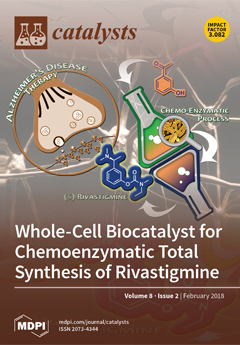A series of Mn-Ce-V-WO
x/TiO
2 composite oxide catalysts with different molar ratios (active components/TiO
2 = 0.1, 0.2, 0.3, 0.6) have been prepared by wet impregnation method and tested in selective catalytic reduction (SCR) of NO by NH
3 in a
[...] Read more.
A series of Mn-Ce-V-WO
x/TiO
2 composite oxide catalysts with different molar ratios (active components/TiO
2 = 0.1, 0.2, 0.3, 0.6) have been prepared by wet impregnation method and tested in selective catalytic reduction (SCR) of NO by NH
3 in a wide temperature range. These catalysts were also characterized by X-ray diffraction (XRD), Transmission Electron Microscope (TEM), in situ Fourier Transform infrared spectroscopy (in situ FTIR), H
2-Temperature programmed reduction (H
2-TPR) and X-ray photoelectron spectroscopy (XPS). The results show the catalyst with a molar ratio of active components/TiO
2 = 0.2 exhibits highest NO conversion value between 150 °C to 400 °C and good resistance to H
2O and SO
2 at 250 °C with a gas hourly space velocity (GHSV) value of 40,000 h
−1. Different oxides are well dispersed and interact with each other. NH
3 and NO are strongly adsorbed on the catalyst surface and the adsorption of the reactant gas leads to a redox cycle with the valence state change among the surface oxides. The adsorption of SO
2 on Mn
4+ and Ce
4+ results in good H
2O and SO
2 resistance of the catalyst, but the effect of Mn and Ce are more than superior water and sulfur resistance. The diversity of valence states of the four active components and their high oxidation-reduction performance are the main reasons for the high NO conversion in this system.
Full article





